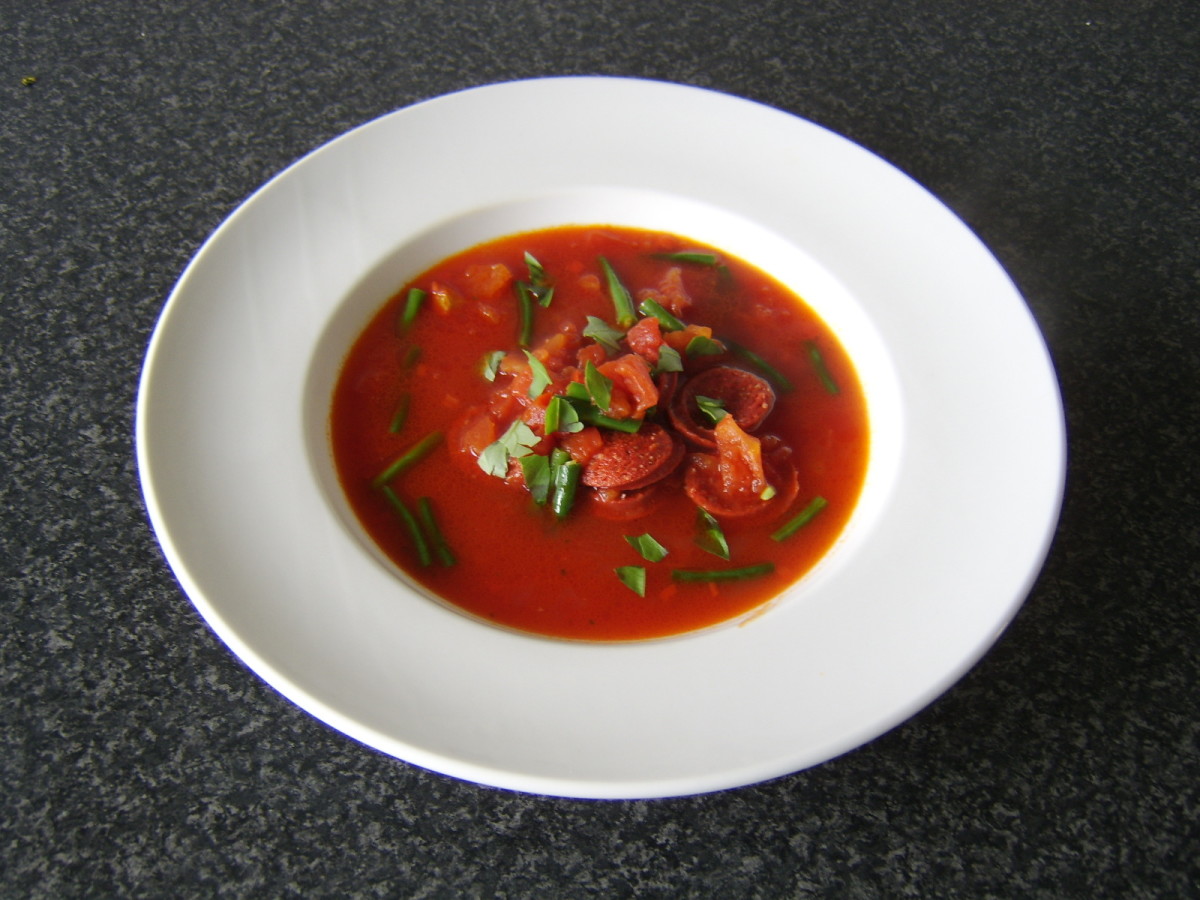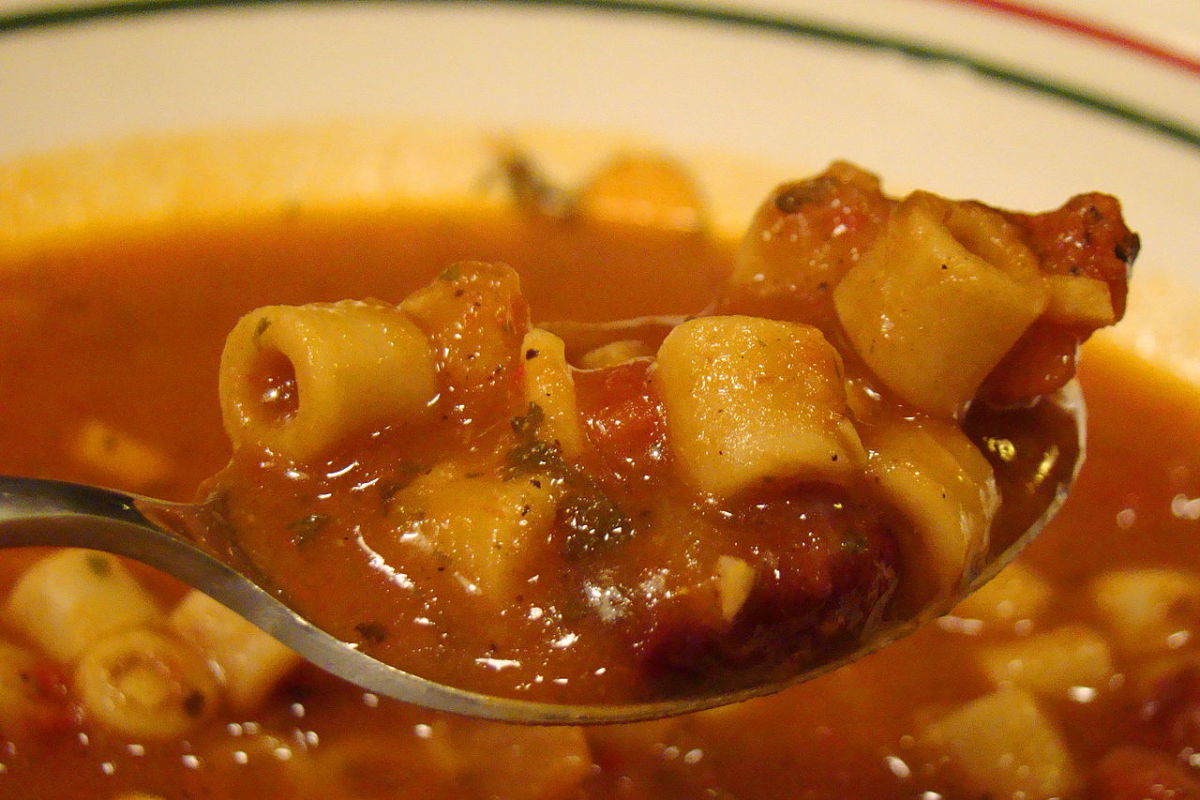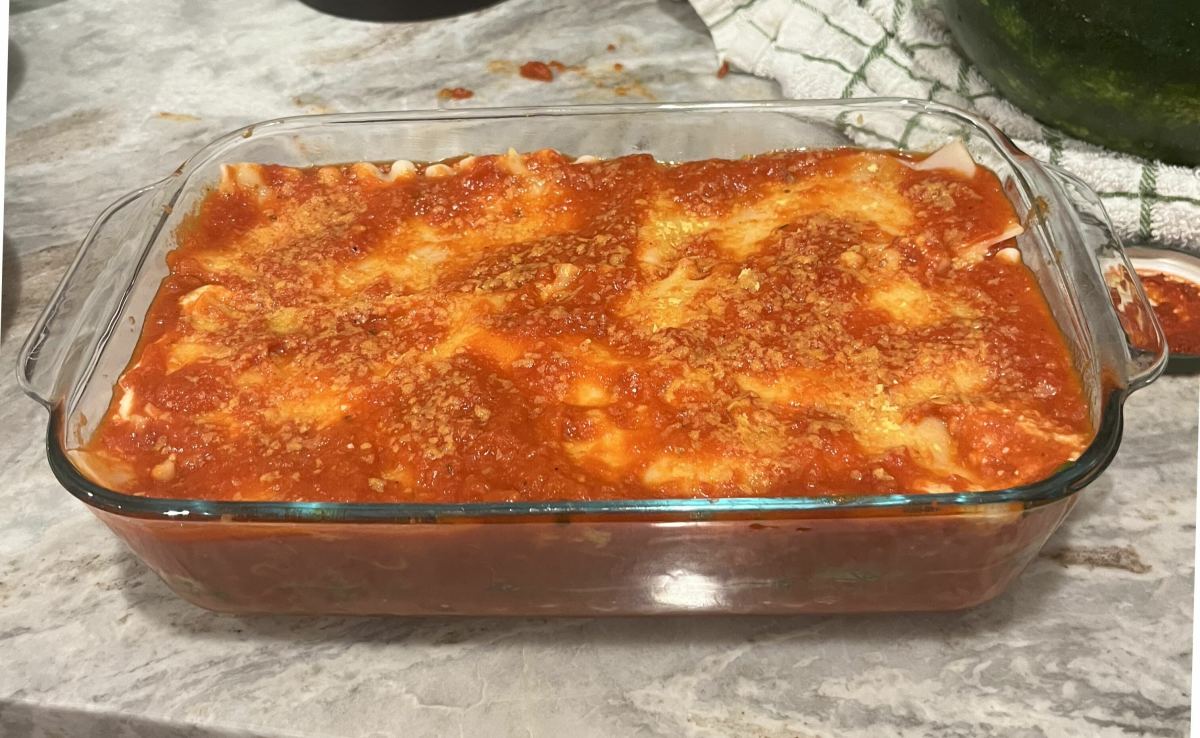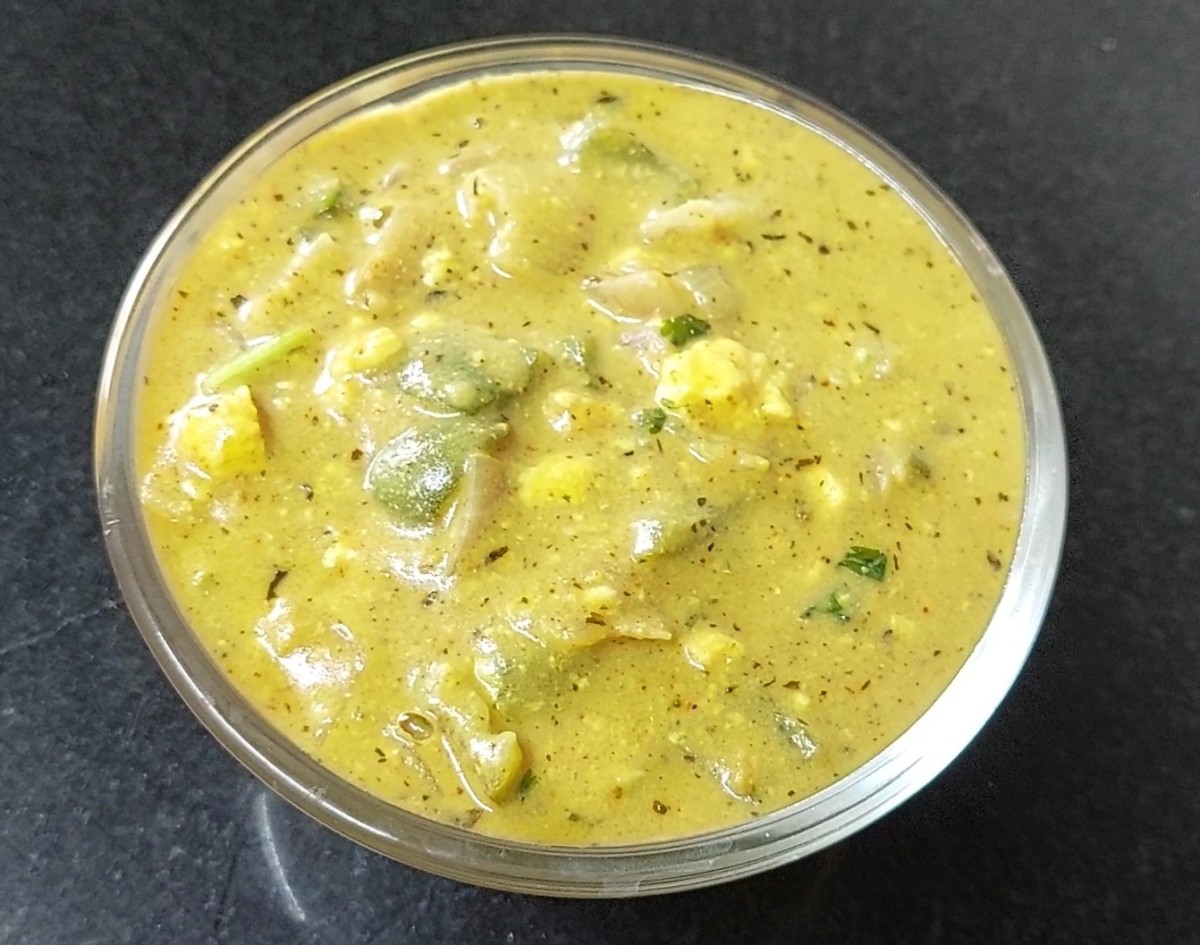The Stockpot and the Art of Soup
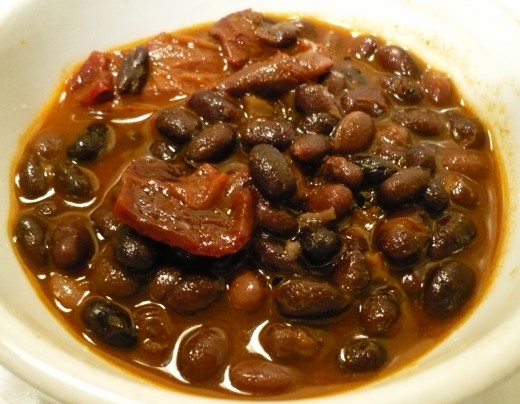

THE IMPORTANCE OF GETTING SOME FOOD INTO YOUR DIET—AND YOU KIDS’ DIETS
Most Americans eat a diet that is heavily laden with highly processed foods—foods that are nutrient-stripped, altered at the molecular level so that they are not so much “food” as a plausible facsimile of food, and crammed with untested chemical additives designed primarily to make substances that are not nourishing seem like food.
Feeding your family good healthy and wholesome food has probably never been more challenging than it is today. Sure, women throughout history, and in every time and clime, have had to deal with all manner of issues related to food. Sometimes the issue has been how to get some, and at almost all times how to have time to prepare food well in the midst of heavy responsibilities of other kinds.
In a way, the modern mom is confronting the first of these food issues: how to get some. If all the fake foods were removed from the grocery shelves, there wouldn’t be much left; the place would be famine central. And modern women also have time constraints.
In 1927, in the days before convenience foods, it is said that the average woman spent five to six hours a day in meal preparation.
Even the stay-at-home housewife of the 1950s was estimated to have spent over three hours a day preparing food—although the reason for this time savings is unclear. I’m thinking that the availability of store-bought bread and prepared pasta may have been factors, and the widespread availability of refrigeration meant that you could fry up chicken or hamburgers in a trice, as opposed to putting the beef from the butcher through the meat grinder to make burgers, or killing and plucking the chicken before dinner. Running water probably made a difference too.
According to Melanie Warner, author of Pandora’s Lunch Box, American women today spend about 30 minutes a day in cooking.
Well, I think we all know one of the big reasons why: Today’s mom is often in the workforce, and many are also single moms.
However, women down through the ages have managed to prepare healthy food, despite similar obstacles. There has probably never been a time in which preparation of food at home, from scratch, has been more important to our—and our children’s—health.
Warner’s book, Pandora’s Lunch Box, which documents thousands of untested food additives, along with the nutrient-stripping methods of processing prepared foods, provides a powerful incentive for preparing real food from scratch for the family.
It’s pretty important to find ways to do this. The “standard American diet” is implicated as the underlying cause of chronic and serious health problems of all kinds—and the incidence of several is increasing dramatically.
Diabetes is a case in point: Diabetes, an ailment that was almost unknown throughout most of human history, has reached epidemic proportions, afflicting more than 26.9% of people over 65 and 13.7% of people aged 45-64.
It is estimated that 35% of Americans aged 20 or older have pre-diabetes—impaired glucose tolerance—a condition in which blood sugars are higher than normal, but not high enough to be diagnosed as diabetic.
What’s worse, a careful look at the diagnostic standards for diabetes reveals that, “Medical experts intentionally set the standards for diagnosing diabetes artificially high, so that most patients will not get diagnosed until their blood sugar reaches a level where they are in serious danger of going blind.”
Finding ways to prepare real food, rather than relying on fast foods and convenience foods, is a matter of the utmost importance—not only for your kids’ health, but for your own, since you are presumably older than they are.
SOUP IS ONE OF THE EASIEST WAYS TO MAKE HEALTHY FOOD FROM SCRATCH FOR YOUR FAMILY
One of my earliest inspirations in this department was Helen Nearing, co-author with husband Scott Nearing of Living the Good Life. Helen and Scott Nearing were the self-sufficiency pioneers of the 1930s, who moved to a Vermont farm, after being black-balled from their former careers in teaching and writing, to live on the land.
Helen was, to begin with, not much of a cook—plus she preferred to spend her time gardening, building stone houses and other structures, and driving the team into the sugar bush at sugaring time to load up the wagon with sap. This lack of both interest in and aptitude for cooking did not stop her from writing cookbooks explaining how she prepared meals. (There was often very little to explain.)
While you can get some idea what the Nearings ate by reading Helen’s cookbook, Simple Food for the Good Life, what they mostly ate, by all accounts, were vegetable soups and raw salads. (They were vegetarians.) Since they often had many guests, raw vegetables were often simply placed on the table in a whole condition, so that everyone could choose, and chop up for themselves “whatever most appealed,” as Scott put it, with a certain malicious relish.
You will probably not want to go that far. But it was from Helen Nearing that I began to get an inkling of the art of soup—and started making some darned good ones.
SOUP IS HEALTHY FAST FOOD
While it may be fair to question the “fast” part, preparation time for good hearty soups made from scratch is not too demanding, especially if you follow Helen Nearing’s modus operandi and reheat the soup over several day, perhaps adding more ingredients. The most healthful and delicious—not to mention thriftiest—way to prepare soup is from homemade soup stock.
After the stock is prepared, making soup is a matter of cutting up ingredients and putting them in the pot to simmer until done. Onions and meats should be sautéed till golden brown in olive oil before adding, because this greatly enhances flavor.
All this cutting up and browning will probably take no more than 30 minutes. If you’ve made stock in advance or kept it simmering in the crock pot since morning (or the night before), all you need do is add the vegetables to the simmering stock and relax while the soup cooks—or do the whole preparation ahead of time, so that the soup can long-simmer in the crock pot.
From the angle of health, there is no healthier food you can prepare for your family than soup, and this is especially true if it’s made from real, homemade soup stock.
Some advocates of healthy eating have insisted that the stockpot is the most important piece of equipment to have in the kitchen. Stocks made from bones of chicken, beef, or fish are in incredible source of minerals, electrolytes (such as calcium, magnesium, and potassium), and gelatin. Stocks made only from vegetables provide a whopping source of most of the same nutrients.
PROPER SOUP-MAKING BEGINS WITH A STOCK POT
The stockpot was formerly omnipresent in every thrifty household. In one of her books, Helen Nearing even remarks with asperity about thriftless neighbors who “did not keep a stock pot.” I mean, how silly can people be?
You may be wondering, “What the heck is a stockpot?”
How They Did It in the Old Days
In former times, it was customary to keep a pot simmering on the stove and use it for depositing many kinds of “scrap” food items: vegetable parings, bones, scraps of gristly meat, leek tops, broccoli stems, tough outer cabbage leaves, the cooking liquid from other vegetables—just about anything clean, sound, and edible, but less palatable.
In due course, the broth was strained off and used as the soup base, or “stock,” for making soup.
I used to proselytize a bit on the subject of homemade soup stock, but I gave it up after a time, because my ideas were so often met with surprise—and sometimes horror. Except for one woman: Once, a number of years ago, I told my soup-making methods to an elderly expatriate Englishwoman at the laundromat, and she replied, “Oh, I’ve always done it that way.”
More recently, I’ve learned that various local churches that are offering “live better on less” seminars and classes are now teaching the nearly lost art of making soup stock.
The traditional way of keeping a stockpot in the days before refrigeration was to keep a pot simmering on the back of the stove, pretty much all the time, into which scrap food items were tossed as they became available. Stock was strained off as needed to make soup, more water added, and more scraps thrown in. You get the impression that the old stock was never thrown out at all to start a new batch, but just kept in continuous service.
Mark Twain tells a story (I’ve searched in vain for it) of being served soup by a Frenchman who declared that he had inherited the stock from a remote ancestor—in preference to his sister, the rightful heir—because “she had married beneath her.”
So you see how this was supposed to work, in the days before refrigeration.
The modern cook has perhaps better options.
Making Soup Stock in the Modern Kitchen
My own experience is that soup prepared from homemade soup stock produces the finest soup I’ve ever made. Using stock, which often can include a wide range of vegetables, as a base for soup, rather than water, adds all the rich flavor of the vegetables used to make the stock
To prepare the stock, I save up kitchen scraps in a freezer bag (or two) and keep them frozen until I have a half-gallon to as much as a gallon of vegetable parings from many kinds of vegetables.
Ingredients for Stock
We are not talking here about using anything spoiled, unwholesome, badly wilted, or unsanitary, nor are we talking about using leftover plate-scrapings for making soup.
The bases for a good soup stock are the well-scrubbed and sound portions of vegetables that are often thrown away. This might include potato, onion, or carrot peelings, or vegetable parts that are too tough, stringy, or fibrous for the table: broccoli stems, leek tops, outer leaves of cabbage, cabbage hearts, collard stems, celery tops, onion parings—the list is nearly endless.
Soup stock is made using only materials that are clean and sound. There’s nothing wrong with them. Actually there’s often a good deal that’s right with them. We often throw away the most nutritious parts of vegetables—the peelings and the darkest green parts of cabbages—because they’re considered tough or unpleasing to look at. Some people even purchase fresh beets and throw away the beet tops, which are absolutely delicious prepared as cooked greens. But if there aren’t enough beet tops to make it worthwhile to cook them up for dinner, they can go into the freezer bag with the other vegetable trimmings.
The Nearings were vegetarians, so their stocks were made entirely from vegetable materials, but soup stocks can also include bones of many kinds of meats. I’ve often used the leftover meat and bones from a roast chicken to prepare chicken broth, or leftover pork of various kinds, to prepare a delicious pork-noodle-mushroom soup. Fish stock, of course, would include fish heads, tails, and bones, and a stock of this kind as the base for fish soups and stews, and miso soup
Fish or chicken stock, or both, would make a fine addition to vegetable stocks for making gumbo, too.
When making stock from bones, it is suggested that stock should be allowed to cook 6-24 hours before straining for use—and the longer the cooking time, the better, for both flavor and nutrition, though it might be best to add vegetable ingredients towards the end of this cooking time. Sometimes it is suggested that adding a small amount of an acidic ingredient, such as acidic wine, vinegar, or lemon juice will help draw minerals into the broth.
Remember, if you’re bothered by using animal materials, that making soup with the venerable “soup bone,” or maybe a ham hock or oxtail, is standard procedure even in modern cookery. Or at least it was the last time I checked. These additions make for a rich, hearty soup, and if you have no bones saved from previous meals, you can often purchase soup bones from your butcher. Ham hocks—which are good, meaty bones—are a favorite for adding to a pot of beans.
How to Save up Ingredients
The sensible way for the modern cook to save up vegetable materials for stock is to keep vegetable parings in a freezer bag in the freezer and add new contributions to the bag as they become available. Eventually you’ll have quite a collection of stuff for making soup stock.
I personally think that the collection of vegetable scraps should include some leek tops and broccoli stems. These two items, along with whatever else you have, seem to produce an especially flavorful stock. The outer layers of onions and the leaves and tops from celery also make the stock especially good.
Making Soup Stock
After you’ve collected about two or more quarts of vegetable scraps in the freezer, it’s time to make soup stock—in preparation for making soup!
Put your collection of frozen vegetable scraps into a large pot, add water to cover, bring to a boil, reduce heat, and simmer for about an hour. Then strain off the stock. You can also make stock in a crock pot and let it simmer for 6-24 hours.
If you are making stock from bones and meat scraps, long cooking time (6-24 hours) is recommended, so as to draw as much of the goodness—minerals and gelatin—from the bones as possible.
After ingredients have finished simmering, the liquid has been strained off and returned to the pot, and other soup ingredients are added.
Making Soup
Now you simply proceed to make soup as usual. You are just substituting stock for some of the water you would normally use. You can see how this will make for a heartier flavor, and it truly does!
A simple vegetable soup can be made simply by adding tomato juice, carrots, potatoes, and onions to the stock and simmering until tender, but many other ingredients are possible: turnips, parsnips, cabbage, leeks, and greens (spinach or kale) are good additions to a vegetarian vegetable soup.
Vegetable soups can also include grains, such as rice, hominy, or barley, or legumes, such as beans, split peas, chickpeas, or lentils. These additions make them more rib-sticking.
TIPS FOR MAKING GOOD SOUP
Obviously, much depends on just what kind of soup you are making: vegetable, a chicken or meat and vegetable soup, or a chicken or meat and noodle soup. Plus there are the really interesting and exotic soups, such as gumbo (loaded with okra and spices), posole (a tangy hominy soup), or black bean soup for serving with rice.
Be Sure to Brown Onions and Meats before Adding
Onions should be sautéed until lightly browned in a good quality oil, such as olive oil, before adding to the soup pot. If you are adding meat or poultry of any kind to the soup, this too should be lightly browned before adding to the soup.
As you know, if you were going to make a pot roast, it would be essential to brown it on all sides before putting it into the pot. There is a reason for this—I mean aside from the fact that the roast will be ruined if you don’t.
Browning of items like meats and onions produces a chemical reaction that creates natural flavor enhancers. Some have compared these compounds to a kind of natural MSG—except that they taste far better and are natural products rather than chemical additives. The caramelized sugars and proteins release complex flavors and aromas that greatly improve the taste of the finished product, whether it’s for soup or pot roast. Lightly browning chopped garlic cloves releases a pleasing nutty flavor.
This chemical reaction, called the Maillard reaction, in which proteins and sugars react at higher temperatures to produce literally dozens of complex flavors and aromas, as well as pleasing colors, has been relied on by good cooks pretty much since the discovery of fire.
Flavor with Herbs
The herbs to be added will, of course, vary, depending on what kind of soup you are making.
To my mind, the most essential herb to add to almost any pot of soup is a bay leaf. Parsley can be added to almost any kind of soup, and celery seed is a good choice for many soups.
Another herb that is a favorite in our family is savory. It is especially good for adding a distinctive touch to very simple soups that might be a little bland without seasoning, such as barley soup, or a simple pot of beans. It’s best to use savory in pinches, as a little goes a long way.
SOME GREAT SOUPS
These are just my recipes. While they have long been family favorites, some are not completely traditional in their preparation. Making these with real homemade stock ensures dazzling flavor.
Vegetarian Vegetable Soup
This simplest of soups becomes deliciously rich when you start with homemade vegetable stock. In fact, stock is one of the keys to making outstanding vegetable soup! I think a bay leaf and some parsley are also essential for a good vegetable soup. The additional of celery seed and savory depend on your personal preferences and mood. A little black pepper seems to be essential in vegetable soup.
Ingredients:
1 quart vegetable stock
1 quart whole tomatoes with juice (tomatoes can be coarsely chopped while still in the can)
1 onion, cut up and sautéed in olive oil till golden brown
4-5 potatoes cut up bite size
4-5 carrots cut into rounds
1 bay leaf
2 tablespoons dried parsley
1 teaspoon ground celery seed (optional)
½ teaspoon savory (optional)
Black pepper to taste
Salt to taste
Put everything in the pot and cook until done.
Black Bean Soup (for Black Beans and Rice)
This recipe comes with a story: My friends and I used to frequent Cuban-Chinese restaurants in New York City, back in the 1970s, where it seemed the whole fashionable world was agog over “black beans and rice.” My very high-toned hairdresser used to pick it up as a carry-out, when he wanted a special treat or was down in the dumps for some reason.
When I returned home to Kansas City, my supervisor at my new job hailed from Louisiana, by way of some combination of relatives. She mentioned making black beans and rice for dinner.
I was astounded! I didn’t know that any mortal beings—except for Cuban-Chinese—actually cooked this as home. (I was very young at the time.) We had a conversation that went:
“You know how to make black beans and rice? Will you give me the recipe? Please, please, please?”
“Sure,” she replied. “Back home, we call it garbage soup.”
This is her recipe, except I have suggested vegetable stock instead of water for cooking the dry beans. This soup can also be made with red beans, which is how she usually made it.
Ingredients:
1-2 quarts vegetable or pork stock
1 pound dry black beans
1 pound smoked sausage slightly browned in olive oil
1 large onion, chopped and sautéed till golden brown
1 large green bell pepper, chopped and sautéed till lightly browned
5-6 cloves garlic, chopped and sautéed till lightly browned
1 bay leaf
1 quart canned whole tomatoes, with juice (tomatoes can be coarsely chopped while still in the can)
1 dried cayenne pepper
1/2 cup vinegar
Salt to taste
Wash and drain beans and soak overnight in vegetable or pork stock to cover, plus about an extra inch or two. Add other ingredients and simmer till beans are tender. Serve over rice. Many people enjoy adding hot sauce at the table.
Chicken Gumbo Soup
This is one of those versions of chicken gumbo that is just ever so good, even if of doubtful authenticity. You are probably supposed to start of with a roux, browned according to your Cajun grandmother’s traditional depth of color. But, since I made this for many years before I ever heard of a roux, I always made it this way.
Ingredients:
1 quart vegetable or chicken stock
1 quart whole tomatoes with juice (tomatoes can be coarsely chopped while still in the can)
4 skinless, boneless chicken breasts, cut up and browned in olive oil
1 pound okra (whole baby okra or cut-up okra)
1 whole onion, chopped and sautéed in olive oil till golden brown
5-6 cloves garlic, chopped and sautéed in olive oil till golden brown
1 bay leaf
1 dried cayenne pepper
2 tablespoons dried parsley
1-2 tablespoons file gumbo
Mrs. Dash Extra Spicy, to taste (I use a lot)
Salt to taste
Filet gumbo is traditionally added at the end of cooking—though I didn’t know that until recently, and I’ve been making chicken gumbo for decades. As for the rest of the ingredients, just put them all in a pot and simmer for about an hour.
Serve over rice. Alternatively, you could add a cup of uncooked rice to the pot, but serving over rice assures that the rice doesn’t get mushy from overcooking.
Posole (Hominy Soup)
Posole is a hominy soup that I usually make with chicken stock, though it is probably more traditional to make it with pork stock.
Ingredients:
1 quart chicken stock
4 skinless, boneless chicken breasts, cut up and browned in olive oil
1 bunch scallions, cut up and sautéed in olive oil
4-6 cloves garlic, chopped and sautéed in olive oil
3 cans yellow hominy, drained
1 jar salsa verde
¼ to 1/2 cup fresh cilantro
1 teaspoon dried oregano
1-2 green chili peppers, diced
1 bay leaf
¼ cup lime juice
Salt to taste
Fresh cilantro for topping
Simmer everything together until the chicken is done and flavors have blended—about an hour. Top with fresh cilantro.
This is an adventurous soup—tangy and unusual—but well liked in our family.
Pork Noodle Mushroom
This recipe is a great way to use the leftover pork roast and its juices (which in a previous existence may have been “pulled pork”). A large pork tenderloin, too, will often serve the family with plenty of leftovers for soup.
I made this soup for the first time at the suggestion of my oldest daughter. All of the girls had after-school jobs at our local five-star restaurant, and it had come to the attention of the eldest that the restaurant used leftover pork to make an astounding pork noodle mushroom soup.
In this case, the stock is simply the leftover meat and juices from pork roast, so I’m cheating a little by including this one.
Stock for this could be made from pork bones, onion and leek parings, and mushroom stems—perhaps not a likely combination in your freezer-bag stash.
Ingredients:
2 quarts water or stock
1 pound leftover pork
1 onion, sautéed in olive oil till golden brown
1 8-ounce package mushrooms, sautéed in butter till golden brown
1 can cream of mushroom soup
1 pound homemade egg noodles, or frozen egg noodles, or Amish-style dried egg noodles
Black pepper to taste
Salt to taste
Put everything but the noodles all together in a pot and cook for about an hour, till flavors are blended. Add noodles and boil gently till noodles are done.

